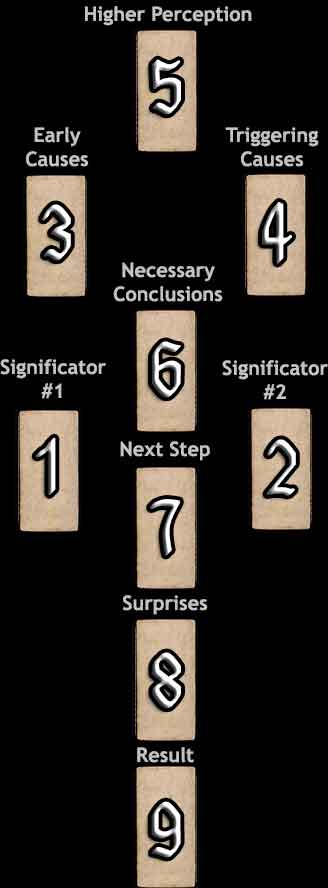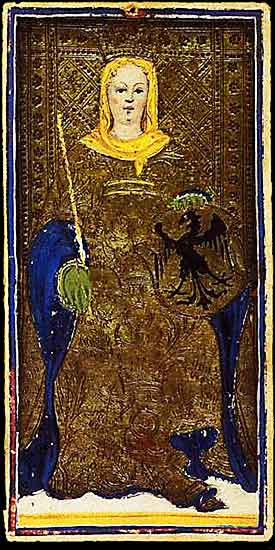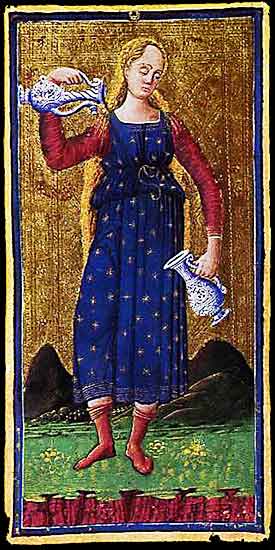Ankh Spread

Difficulty: Kind of tough
The Ankh Spread is for questions about the causes behind trends. It is similar to the Celtic Cross and Secret of the High Priestess spreads, but it covers the reasons behind the circumstances in question differently, perhaps giving a better explanation of why things are the way they are.
The loop of the upper section of the ankh reveals the spiritual background and causes of the situation, while the stem of the base focuses on prospects for the outcome.
The first two tarot cards represent the two parent causes of the situation. They will either complement each other or show two opposing sides of a conflict, depending on how they relate. These are the significator cards of the Ankh spread.
3. This tarot card shines light upon the early causes of the trend in question.
4. Pinpoints the causes that triggered the current situation.
5. Reveals the spiritual perspective of the subject at hand.
6. This card examines the reasons why this course of action had to unfold, as a means to this end.
At this point, it is good to pause to soak in the meaning of the first six cards before moving forward to the last three cards. The last three reveal prospects for the future.
7. The Next Step gives clues about the immediate future.
8. Surprising Experiences encountered en route to the result.
9. This represents the result.
Your Ankh Reading
Higher Perceptions  III – The Empress |
||
Early Causes
 XIV – Temperance |
Triggering Causes
 I – The Magician |
|
Necessary Conclusions
 IV – The Emperor |
||
Significator #1
 VI – The Lovers |
Significator #2
 0 – The Fool |
|
Next Step
 II – The Popess |
||
Surprising Experiences  VIII – Justice |
||
Outcome  XI – Strength |

Significator #1
VI – The Lovers
The Lovers represent choice and the uniting of opposites. It embodies the transformative power of love and the necessity of making meaningful decisions.
Symbolism: The young couple standing beneath Cupid symbolises connection and divine guidance in love. The formal Renaissance clothing and the golden background elevate their union to a sacred level, while the static composition emphasises balance and deliberate choice.
In Relationships: A powerful connection that unites hearts and souls. It may signify a new relationship or a pivotal choice in love.
In Work: A partnership or decision with far-reaching consequences. The Lovers encourage the alignment of values with your work.
Spiritually: The Lovers symbolise unity with your higher self and the harmonious integration of opposites.
When ill-dignified: Temptation, discord, or indecision. It warns against superficial connections or poor choices.

Significator #2
0 – The Fool
The Fool symbolises new beginnings, innocence, and an open-hearted journey. He represents the spirit of adventure and trust in the unknown, unburdened by experiences or material concerns. His path is one of discovery, where curiosity leads the way.
Symbolism: The vagabond's tattered clothing reflects detachment from societal norms, while his staff and bundle suggest minimal baggage—both physical and emotional. The golden background highlights his eternal and universal journey. His carefree, open-mouthed expression conveys both the naivety of youth and the wisdom of freedom from expectations.
In Relationships: A signal to take risks or approach relationships with spontaneity and trust. It cautions against naivety or reckless behaviour.
In Work: An invitation to embrace a new path or project with an open mind. The Fool encourages experimentation and trust in one's instincts.
Spiritually: The Fool represents faith in the journey ahead and the courage to step into the unknown. He invites the seeker to trust the divine flow.
When ill-dignified: Foolishness, poor judgement, or recklessness. It warns against ignoring practicalities or rushing ahead blindly.

Early Causes
XIV – Temperance
Temperance represents harmony, balance, and the art of blending opposites. It suggests a time of calm, careful moderation, and the synthesis of differing energies into a cohesive whole.
Symbolism: Pouring liquid from one vessel to another symbolises the balance and exchange between opposing forces—emotion and intellect, fire and water, inner and outer worlds. Her graceful posture and tranquil demeanour indicate deliberate action, emphasising that peace comes through moderation. The golden background elevates balance to the divine level, suggesting that harmony is sacred.
In Relationships: Temperance encourages balance in relationships. It asks for patience and moderation in interactions, fostering an environment where both partners can harmonise their differences.
In Work: Success comes through collaboration and maintaining equilibrium. This card advises you to blend your talents with those of others, seeking compromise rather than extremes.
Spiritually: Temperance represents spiritual equilibrium. It calls for integrating the material and spiritual worlds, balancing one's desires and needs for peace and alignment.
When ill-dignified: Imbalance, excess, or a lack of harmony. This could indicate dissonance in relationships, career, or spiritual practice, warning against overindulgence or extremes.

Triggering Causes
I – The Magician
The Magician embodies skill, potential, and the power to manifest. He represents the mastery of tools and resources, as well as the confidence to create one's reality. This card speaks of the importance of focus and action in shaping personal success.
Symbolism: The Magician's table holds simple tools, symbolising practical skills and raw materials. His Renaissance attire conveys refinement and expertise, while the golden background suggests his elevated role in shaping the material world. His seated position emphasises composure and control over his craft.
In Relationships: A call to use charm and communication to strengthen relationships. It warns of manipulation if ill-intentioned.
In Work: A time to take initiative and harness your abilities to achieve success. The Magician encourages innovation and confidence.
Spiritually: The Magician bridges the physical and spiritual, reminding the seeker to channel divine inspiration into practical actions.
When ill-dignified: Misuse of skills, deception, or scattered energy. It warns against overconfidence or manipulation.

Higher Perceptions
III – The Empress
The Empress symbolises abundance, creativity, and nurturing energy. She represents the generative force of nature and the ability to create and sustain growth, both literally and figuratively.
Symbolism: The Empress's sceptre and crown symbolise her authority, while her shield connects her to the Visconti family lineage. The floral embroidery on her gown reflects her connection to nature and fertility. The golden background underscores her divine and regal status.
In Relationships: A time of emotional abundance and nurturing. The Empress signals love, harmony, and growth.
In Work: Creative projects flourish under the Empress's guidance. She encourages nurturing ideas and building strong foundations.
Spiritually: The Empress represents the divine feminine, inviting the seeker to embrace growth and connect with nature's rhythms.
When ill-dignified: Stagnation, overindulgence, or a smothering presence in relationships.

Necessary Conclusions
IV – The Emperor
The Emperor symbolises structure, authority, and stability. He represents the power of rules and order to create security and success, though sometimes at the expense of flexibility.
Symbolism: Seated upright with a sceptre and orb, the Emperor exudes control and dominion. His luxurious robes and the golden background emphasise his regal and unshakable power. His stillness reflects his role as a protector of order and enforcer of discipline.
In Relationships: A relationship built on structure and commitment. It can suggest the presence of a protective partner or the need to establish boundaries.
In Work: Leadership, organisation, and discipline are essential for achieving success. The Emperor encourages taking control and assuming responsibility.
Spiritually: The Emperor teaches the importance of structure and discipline in spiritual practice, encouraging grounded growth.
When ill-dignified: Tyranny, rigidity, or abuse of power. It warns against controlling behaviours or excessive adherence to rules.

The Next Step
II – The Popess
The Popess signifies intuition, mystery, and hidden wisdom. She represents the need to look inward and trust one's inner voice while respecting the unknown and unseen.
Symbolism: Her veil and book symbolise the sacred mysteries she guards. The golden background elevates her presence, while her fancy robes reflect the complexity of her spiritual knowledge. Her composed demeanour conveys her role as a keeper of divine truths.
In Relationships: A time to trust your instincts. The Popess may suggest unspoken feelings or the need for patience.
In Work: Hidden opportunities or knowledge may come to light. Use intuition and discretion when making decisions.
Spiritually: A call to explore inner wisdom and the mysteries of life. Trust the subtle guidance of intuition.
When ill-dignified: Secrets, deception, or an overreliance on logic at the expense of intuition.

Surprises
VIII – Justice
Justice represents fairness, balance, and accountability. It signifies the importance of truth and the consequences of one's actions, urging you to act with integrity.
Symbolism: The seated figure holds a sword and scales, embodying fairness and the enforcement of law. The richly adorned gown and golden background highlight the divine and universal nature of justice, while the knight in the background underscores executive authority.
In Relationships: A need for honesty and balance. Justice may signal the resolution of conflicts or the importance of mutual respect.
In Work: Fair rewards for effort and accountability for mistakes. Justice encourages acting with integrity and taking responsibility.
Spiritually: Justice emphasises the law of karma and the importance of living a life aligned with truth and fairness.
When ill-dignified: Bias, dishonesty, or imbalance. It warns against unfair judgements or evading accountability.

The Outcome
XI – Strength
Strength symbolises courage, patience, and the mastery of inner power. It reflects the triumph of compassion and self-control over brute force.
Symbolism: The figure's calm restraint of the lion reflects the balance of strength and gentleness. Her finely detailed garments and the rendering of the lion's mane reflect Renaissance artistry, while the golden background elevates the scene to a symbolic level.
In Relationships: A time to practise patience and understanding. Strength signals harmony through compassion.
In Work: Success through persistence and confidence. Strength encourages inner resolve rather than aggressive tactics.
Spiritually: Strength represents mastering the ego and cultivating inner peace through compassion.
When ill-dignified: Aggression, self-doubt, or weakness. It warns against succumbing to fear or forceful behaviours.